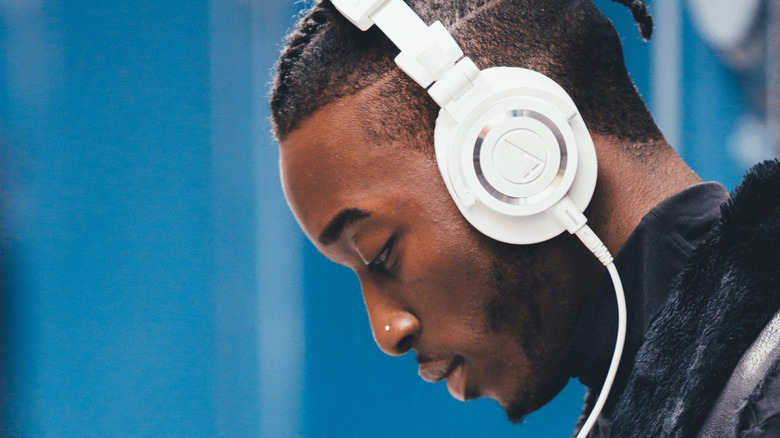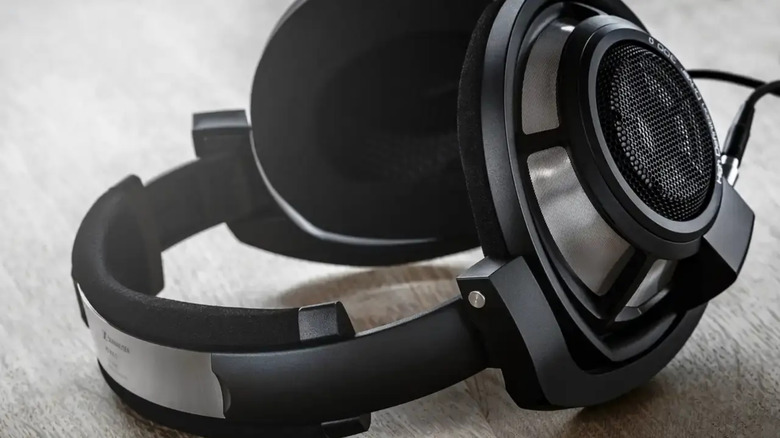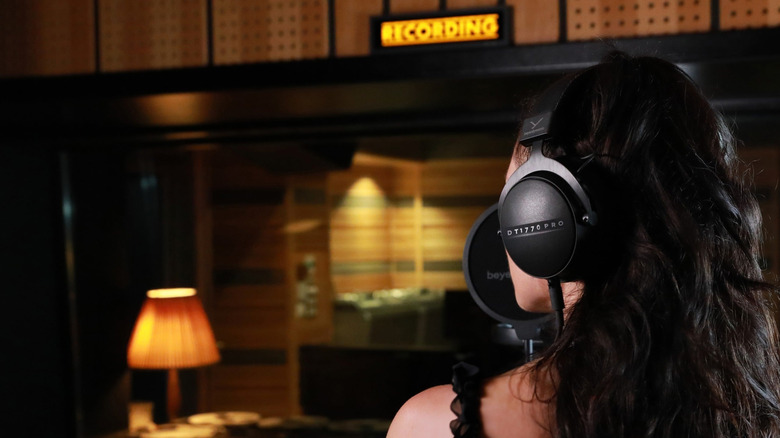What Are Studio Grade Headphones, And When Are They Useful?
We may receive a commission on purchases made from links.
While browsing headphones, you may have noticed the term "studio grade" cropping up here and there. It's a marketing term sometimes used to differentiate between categories of headphones. As you might intuit, studio headphones are geared toward working musicians. But if you're not a musician — and therefore don't have a studio — should you pay any attention to studio grade headphones?
In the simplest terms, studio grade headphones should aim to provide a completely neutral and accurate listening experience, ensuring that artists get an accurate idea of the music they're working on in the studio. That may sound a bit strange at first blush. After all, isn't accuracy the goal of every headphone? Well, not actually. As opposed to studio headphones, consumer grade audio equipment often aims to enhance aspects of music that the average listener finds pleasing. For example, modern pop, hip hop, EDM, and other popular genres tend to have a lot of bass, so consumer headphones (for example, the Sony Ult Wear) often emphasize the low end of the frequency spectrum to make those genres sound better. A studio grade headphone, on the other hand, aims to make sure no part of the spectrum is amplified.
There are a number of reasons why someone might gravitate toward studio grade headphones, even if they aren't a musician. For those who enjoy a high quality audio experience, or for audio purists who prioritize clinical accuracy over consumer sound profiles, studio grade headphones can be the perfect solution. Cheap but well-performing cans like the popular Audio Technica ATH-M50x are priced at under $200, while more premium pairs like the famous Sennheiser HD 800 S cost tenfold that. Here's what you need to know.
Studio grade headphones prioritize transparency and no-frills accuracy
Studio grade headphones, which may also be marketed as professional, monitoring, or reference headphones, are engineered with an ear toward transparency and critical listening. That means they aim to preserve all the detail in a recording, and to reproduce it with a flat signal — in other words, no portions of the audio spectrum, from bass to mids and highs, are lowered or raised. While in a studio environment, headphones with a clinical sound are crucial to ensuring that a song doesn't end up with too much treble, not enough bass, or anything else that might compromise the mix. For music consumers, who consider themselves audiophiles, these sorts of headphones are often a way to ensure their listening experience matches the artist's creation as closely as possible.
Studio headphones are almost always over-ear, meaning they seal around your ears without touching them. They come in open-back and closed-back varieties. Open-back headphones do not prevent airflow from outside the headphone, and often have a mesh grille to allow for the surrounding environment to penetrate into the headphone. This might sound odd, but it actually creates a more accurate sound in a quiet studio, and is often preferred when mixing music. Closed-back headphones, meanwhile, are best for noisy environments and recording sessions since their solid construction passively blocks noise. This helps to prevent sound bleed, which is when a backing track played in headphones gets picked up by a high quality studio microphone. Open-back headphones make it difficult to record a vocal without the backing track leaking into the microphone, so they're best left for the mixing table. Most professional musicians and sound engineers will find it necessary to own at least one pair of each.
Do you need studio headphones if you're not a musician?
As mentioned earlier, studio grade headphones are designed with clinical precision in mind, aiming to provide a flat sound that doesn't change the original audio signal. Yes, this does mean you're probably not listening to your music the way the artist heard it in the studio. However, that's not necessarily a bad thing. While many music enthusiasts do prefer a flat signal, deeming it the most true to life, other music fans embrace their preference for a particular EQ.
Unless you're a musician, the choice boils down to your personal priorities. Studio musicians are well aware their music will end up being played on a range of devices that vary in quality and sound profile. Therefore, a lot of the mixing and mastering process is focused on making sure a track will sound as good as possible on a wide range of popular devices. Anecdotally, I've spoken to a few successful musicians who listen to final mixes on AirPods, since they know that's how a significant portion of their audience will hear them. So, when choosing between studio grade headphones and the best Bluetooth headphones, consider this: do you want to feel like you're experiencing music as the artist envisioned, or do you have a strong preference for a particular sonic profile? There's no shame in being a basshead.
However, another benefit to studio grade headphones is that they're flexible. Even if you do prefer to tweak the sound of your music, you can always take studio grade headphones and slap an EQ on top of them. Going the other direction is a lot harder, though. Check out our guide on finding the best EQ settings if you want to open that particular can of worms.


